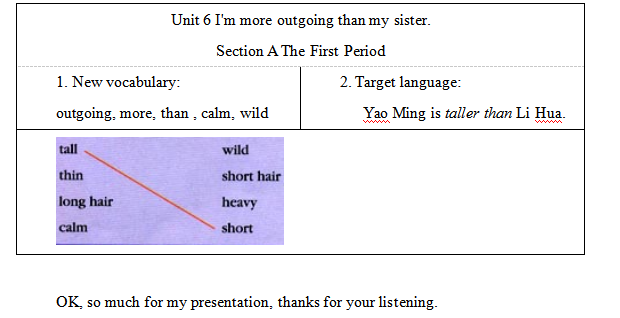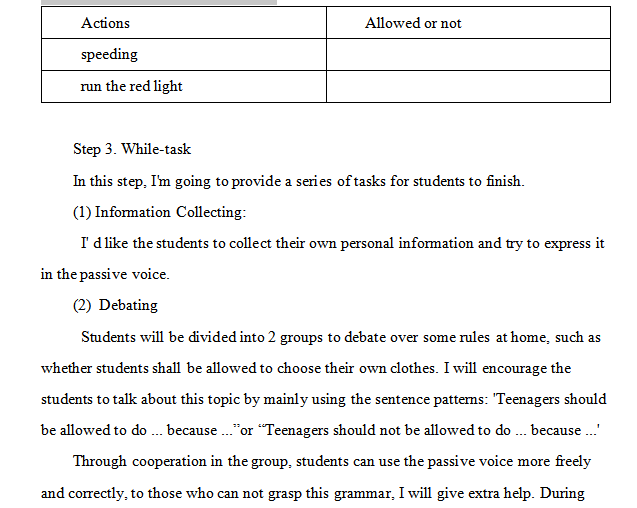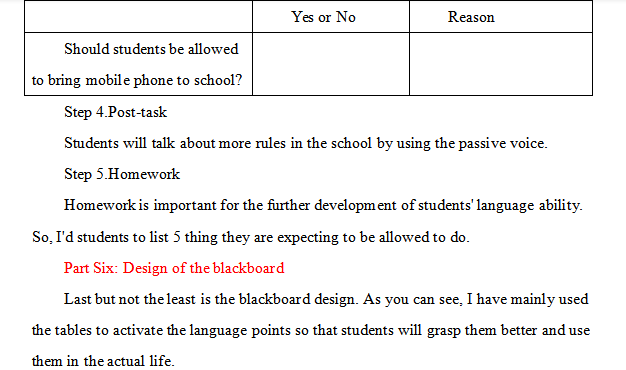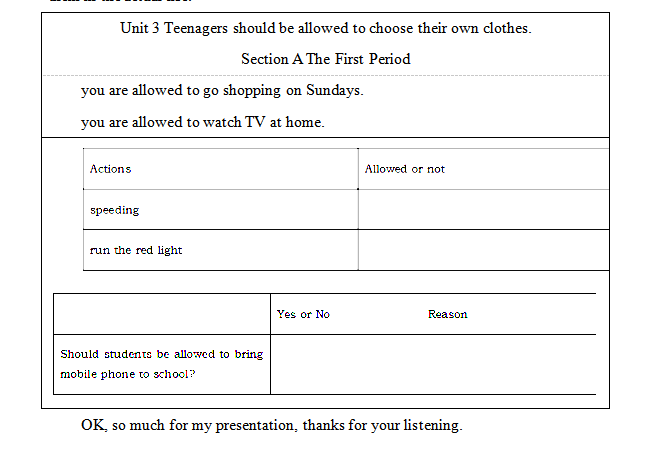温馨提示:本文涉及以下内容请翻页阅读
说课稿 人教版 英语 八年级 上册 Unit 6 I'm more outgoing than my sister (Section A)
说课稿 人教版 英语 九年级 Unit 3 Teenagers should be allowed to choose their own clothes (Section A)
Unit 6 I'm more outgoing than my sister
(Section A)
Good morning/ afternoon, dear judges! I'm very glad to be here to present my class today. I'm number X candidate applying for the English teacher of the secondary school. And my topic today is Unit 6 I'm more outgoing than my sister. To get a better understanding of my instructional designing, I'm going to divide it into 6 sections, that is, the analysis of teaching materials, analysis of students, teaching methods, learning methods, teaching procedures and blackboard design. Now I am going to present them one by one.
Part One: Analysis of the Teaching Material
The first and foremost is the analysis of the teaching materials. Today's lesson is the Unit 6, Section A of Go For It, 8A, published by People's Education Press. Its main theme is talking about people's physical appearance, which is a common topic among students. Actually they all have had such experience to use language to describe others, so this lesson will be quite useful to students' daily life.
Based on the New Curriculum Standard,today's teaching objectives are as follows:
1. Knowledge objectives
Knowledge objective is to master the usage of new words: outgoing, more, than , calm, wild.
2. Ability objectives
Ability objective is to grasp how to use the comparative form of the adjective to describe two persons.
3. Emotional objectives
Emotional objective is to enhance students interests in learning English.
Given the teaching materials and the students' characteristics, I suppose the teaching key and difficult points are the comparative form of adjectives and how to use it in real situations.
Part Two: Analysis of the students
OK, let's turn to the analysis of students. Students of Grade 8 have studied English for at least 5 years and grasped a certain amount of English knowledge. They are eager to show, eager to learn. They can cooperate with their classmates to finish a task. On the other hand, students' ability of using English is limited; their abstract thinking is not fully developed and they can be easily distracted. Therefore, all of these shall be taken into consideration into today's teaching.
Part Three: The Teaching Methods
According to the analysis of teaching materials and students, I'm going to arrange my lesson by mainly using the Task-based Method.
Part Four: The Learning Methods
The learning Methods of this lesson will be focused on cooperative and researched methods. Students will finish a series of activities to learn the language points today.
Teaching Aids
During the teaching process, recorder, CAI, picture and computer will be needed.
Part Five: Teaching Procedures
OK, so much for the teaching and learning methods. And the next one is the most important part of today, the teaching procedures, which will be demonstrated in the following steps:
Step 1.Leading-in
In order to make the class more lively and interesting, firstly I'm going to ask several students to introduce themselves. Students will be told to focus on their looking and characters. By doing so, students will get a general idea of today's lesson and their interest will be raised as well.
Step 2. Pre-task
1. Vocabulary Focus:
In this step, I'll introduce the new words firstly. I will show some pictures to the students and ask them to tell what they see. Pictures with different persons with different features will give a direct image to students and I'll teach them how to read these words"outgoing, more, than , calm, wild" .
Then, I'm going to write the new words on the blackboard and ask the students to try to make up sentences using the words :tall ,wild , thin , long hair , short hair , heavy , calm , short and so on. Here is an example: Yao Ming is taller than Li Hua.
2. Discussion
After the Vocabulary Focus, I'm going to write a table on the blackboard. Then I'd like the students to work in groups to discuss and match the word and its opposites. Students will fill in the table below.

Step 3. While-task
In this step, I'm going to provide a series of tasks for students to finish and practice today's grammar.
(1) I'll Call students attention to the picture in page 31, and point out the sample conversation in activity 1c. Then I'd like students to work with their partners to make their own conversation about the twins .
(2) Role-play and listen: I will invite several pairs to present their conversations and write them on the blackboard. Then I'd like the students to listen to the recording and number the twins. After that, I will put the answer on the screen and check with the students .
(3)Grammar Focus: I'll point out the two columns and read the headings :-er , -ier and more in 2a. Then I'll point out the words in the box and lead the students to read. Later, I'll ask students to listen and write the –er and –ier words in the first column and the words that use more in the second column. I will play the recording again and check the answers .
(4)Box Filling: I'm going to play the recording 2b and point out the picture and the two boxes with the headings Tina is and Tara is. Then I'd like the students to fill in the boxes. The words are from the list in activity 2a. After that I'll play the recording and check the answers.
Step 4.Post-task
Pair Work: Post-task will be focused on the comparative form of the adjective continually. So, I'll point out the chart in activity 2c and ask students to make their own conversations according to the information.
Step 5.Homework
Homework is important for the further development of students' language ability. So, I'd students to describe how the students and their sisters or brothers are different and write the difference down .
Part Six: Design of the blackboard
Last but not the least is the blackboard design. As you can see, I have mainly used the table to activate the language points so that students will grasp them better and use them in the actual life.
Unit 6 I'm more outgoing than my sister.
Section A The First Period
1. New vocabulary:
outgoing, more, than , calm, wild2. Target language:
Yao Ming is taller than Li Hua.

Unit 3 Teenagers should be allowed to choose their own clothes
(Section A)
Good morning/ afternoon, dear judges! I'm very glad to be here to present my class today. I'm number X candidate applying for the English teacher of the secondary school. And my topic today is Unit 3 Teenagers should be allowed to choose their own clothes. To get a better understanding of my instructional designing, I'm going to divide it into 6 sections, that is, the analysis of teaching materials, analysis of students, teaching methods, learning methods, teaching procedures and blackboard design. Now I am going to present them one by one.
Part One: Analysis of the Teaching Material
The first and foremost is the analysis of the teaching materials. Today's lesson is the Unit 3, Section A of Go For It, Grade 9, published by People's Education Press. Its main theme is about talking about what students are allowed to do. In our everyday life, students have encountered different kinds of rules more or less, so they will be very interested in today's topic. What's more, if they are allowed to choose their own clothes freely just like the title implies, they will be much more excited.
Based on the New Curriculum Standard,today's teaching objectives are as follows:
1. Knowledge objectives
Knowledge objective is to master the usage of " be + past participle".
2. Ability objectives
Ability objective is to grasp how to talk about approval and disapproval by using the sentence pattern "be allowed to" .
3. Emotional objectives
Emotional objective is to encouraged the students to understand and reflect on their everyday behavior.
Given the teaching materials and the students' characteristics, I suppose the teaching key and difficult points are the usage of "could, should" and how to talk about problems and give advice in real situations.
Part Two: Analysis of the students
OK, let's turn to the analysis of students. Students of Grade 9 have studied English for at least 6 years and grasped a certain amount of basic English knowledge. They are active, eager to show and learn; their abstract thinking is developing rapidly, they can cooperate with their classmates to finish tasks, they can make their own judgments based on their life experience. On the other hand, students of Grade 9 cannot use English freely; they make mistakes now and then, and their attention span is limited. Therefore, I should take into account all of these factors in my teaching.
Part Three: The Teaching Methods
According to the analysis of teaching materials and students, I'm going to arrange my lesson by mainly using the Task-based Method.
Part Four: The Learning Methods
The learning Methods of this lesson will be focused on cooperative and researched methods. Students will finish a series of activities to learn the language points today.
Teaching Aids
During the teaching process, recorder, CAI and computer will be needed.
Part Five: Teaching Procedures
OK, so much for the teaching and learning methods. And the next one is the most important part of today, the teaching procedures, which will be demonstrated in the following steps:
Step 1.Leading-in
In this step, I'm going to lead in today's topic by introducing some common questions about students in their life. An example is given below:
T: What do your parents let you do at home?
S1: My mother lets me go shopping on Sundays.
T: That sounds nice.So you are allowed to go shopping on Sundays. What about you, Tracy?
S2: My father lets me watch TV at home.
T: Good. So you are allowed to watch TV at home.
Then, I'm going to write two sentences with the passive voice on the blackboard and ask students to discuss what they can do at home. Students shall make a list.
By doing so, students will get a general idea of today's lesson and their interest will be raised as well.
Step 2. Pre-task
1. Thinking:
In order to get the students to be more familiar with today's topic, I' d like them to have a thinking game first. I'll show the students some pictures, in which some people are against the rules, such as run the red light, speeding. Then Ss shall think about why these actions should not be allowed.
2. Discussion
During students' thinking, I'm going to write a table on the blackboard. Then I'd like the students to work in groups to talk about the situation and give their judgment. Students will fill in the table below.

Step 3. While-task
In this step, I'm going to provide a series of tasks for students to finish.
(1) Information Collecting:
I' d like the students to collect their own personal information and try to express it in the passive voice.
(2) Debating
Students will be divided into 2 groups to debate over some rules at home, such as whether students shall be allowed to choose their own clothes. I will encourage the students to talk about this topic by mainly using the sentence patterns: 'Teenagers should be allowed to do ... because ...”or “Teenagers should not be allowed to do ... because ...'
Through cooperation in the group, students can use the passive voice more freely and correctly, to those who can not grasp this grammar, I will give extra help. During the course, I will emphasize the correct structure of the passive voice now and then. Often students will talk about the following sentences:
I am allowed to watch TV for half an hour every night.
I am allowed to go shopping with friends once a week.
I am not allowed to play computer games every night.
I'll show these sentences on the screen and invite some students to talk about their ideas by using the pattern:Teenagers should be allowed to do sth.
(3)Extension
To encourage the students to use the language creatively and master the passive voice by speaking, I will continue to provide one topic for students to discuss. The question is "Should students be allowed to bring mobile phone to school?" Students will work on groups to discuss this, give their answer and reason.












